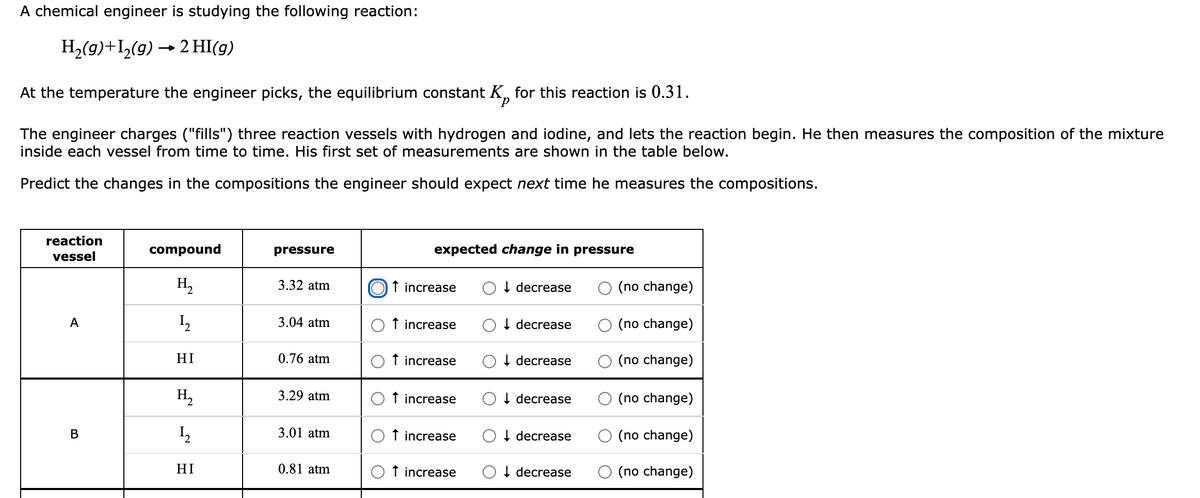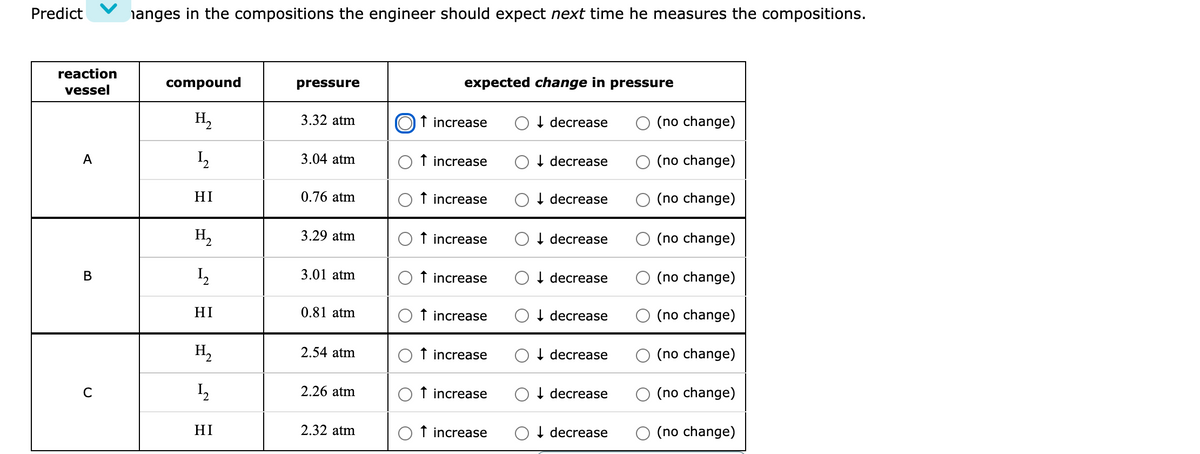ieer is H2(9)+I½(9) → 2 HI(g) At the temperature the engineer picks, the equilibrium constant K, for this reaction is 0.31. The engineer charges ("fills") three reaction vessels with hydrogen and iodine, and lets the reaction begin. He then measures the composit inside each vessel from time to time. His first set of measurements are shown in the table below. Predict the changes in the compositions the engineer should expect next time he measures the compositions. reaction compound pressure expected change in pressure vessel H, 3.32 atm Ot increase I decrease O (no change) A 3.04 atm O t increase O I decrease O (no change) HI 0.76 atm O t increase O I decrease O (no change) H, 3.29 atm O t increase I decrease O (no change) 3.01 atm O t increase I decrease O (no change) HI 0.81 atm O t increase O I decrease O (no change)
ieer is H2(9)+I½(9) → 2 HI(g) At the temperature the engineer picks, the equilibrium constant K, for this reaction is 0.31. The engineer charges ("fills") three reaction vessels with hydrogen and iodine, and lets the reaction begin. He then measures the composit inside each vessel from time to time. His first set of measurements are shown in the table below. Predict the changes in the compositions the engineer should expect next time he measures the compositions. reaction compound pressure expected change in pressure vessel H, 3.32 atm Ot increase I decrease O (no change) A 3.04 atm O t increase O I decrease O (no change) HI 0.76 atm O t increase O I decrease O (no change) H, 3.29 atm O t increase I decrease O (no change) 3.01 atm O t increase I decrease O (no change) HI 0.81 atm O t increase O I decrease O (no change)
General Chemistry - Standalone book (MindTap Course List)
11th Edition
ISBN:9781305580343
Author:Steven D. Gammon, Ebbing, Darrell Ebbing, Steven D., Darrell; Gammon, Darrell Ebbing; Steven D. Gammon, Darrell D.; Gammon, Ebbing; Steven D. Gammon; Darrell
Publisher:Steven D. Gammon, Ebbing, Darrell Ebbing, Steven D., Darrell; Gammon, Darrell Ebbing; Steven D. Gammon, Darrell D.; Gammon, Ebbing; Steven D. Gammon; Darrell
Chapter14: Chemical Equilibirum
Section: Chapter Questions
Problem 14.16QP: An experimenter places the following concentrations of gases in a closed container: [NOBr] = 7.13 ...
Related questions
Question

Transcribed Image Text:A chemical engineer is studying the following reaction:
H2(g)+I½(g) → 2 HI(g)
At the temperature the engineer picks, the equilibrium constant K, for this reaction is 0.31.
The engineer charges ("fills") three reaction vessels with hydrogen and iodine, and lets the reaction begin. He then measures the composition of the mixture
inside each vessel from time to time. His first set of measurements are shown in the table below.
Predict the changes in the compositions the engineer should expect next time he measures the compositions.
reaction
compound
pressure
expected change in pressure
vessel
H,
3.32 atm
f increase
I decrease
(no change)
A
3.04 atm
f increase
I decrease
(no change)
HI
0.76 atm
f increase
O I decrease
(no change)
H,
3.29 atm
f increase
I decrease
(no change)
В
3.01 atm
f increase
I decrease
(no change)
HI
0.81 atm
f increase
O 1 decrease
O (no change)

Transcribed Image Text:Predict
anges in the compositions the engineer should expect next time he measures the compositions.
reaction
compound
pressure
expected change in pressure
vessel
H,
3.32 atm
f increase
I decrease
(no change)
A
3.04 atm
f increase
decrease
(no change)
HI
0.76 atm
f increase
I decrease
(no change)
H,
3.29 atm
f increase
I decrease
(no change)
В
12
I,
3.01 atm
f increase
O 1 decrease
(no change)
HI
0.81 atm
f increase
O I decrease
O (no change)
2.54 atm
f increase
O 1 decrease
(no change)
I2
2.26 atm
f increase
I decrease
(no change)
HI
2.32 atm
f increase
O I decrease
(no change)
Expert Solution
This question has been solved!
Explore an expertly crafted, step-by-step solution for a thorough understanding of key concepts.
Step by step
Solved in 4 steps

Knowledge Booster
Learn more about
Need a deep-dive on the concept behind this application? Look no further. Learn more about this topic, chemistry and related others by exploring similar questions and additional content below.Recommended textbooks for you

General Chemistry - Standalone book (MindTap Cour…
Chemistry
ISBN:
9781305580343
Author:
Steven D. Gammon, Ebbing, Darrell Ebbing, Steven D., Darrell; Gammon, Darrell Ebbing; Steven D. Gammon, Darrell D.; Gammon, Ebbing; Steven D. Gammon; Darrell
Publisher:
Cengage Learning

Chemistry: The Molecular Science
Chemistry
ISBN:
9781285199047
Author:
John W. Moore, Conrad L. Stanitski
Publisher:
Cengage Learning

Chemistry for Engineering Students
Chemistry
ISBN:
9781337398909
Author:
Lawrence S. Brown, Tom Holme
Publisher:
Cengage Learning

General Chemistry - Standalone book (MindTap Cour…
Chemistry
ISBN:
9781305580343
Author:
Steven D. Gammon, Ebbing, Darrell Ebbing, Steven D., Darrell; Gammon, Darrell Ebbing; Steven D. Gammon, Darrell D.; Gammon, Ebbing; Steven D. Gammon; Darrell
Publisher:
Cengage Learning

Chemistry: The Molecular Science
Chemistry
ISBN:
9781285199047
Author:
John W. Moore, Conrad L. Stanitski
Publisher:
Cengage Learning

Chemistry for Engineering Students
Chemistry
ISBN:
9781337398909
Author:
Lawrence S. Brown, Tom Holme
Publisher:
Cengage Learning

Principles of Modern Chemistry
Chemistry
ISBN:
9781305079113
Author:
David W. Oxtoby, H. Pat Gillis, Laurie J. Butler
Publisher:
Cengage Learning

Chemistry
Chemistry
ISBN:
9781305957404
Author:
Steven S. Zumdahl, Susan A. Zumdahl, Donald J. DeCoste
Publisher:
Cengage Learning

Chemistry: An Atoms First Approach
Chemistry
ISBN:
9781305079243
Author:
Steven S. Zumdahl, Susan A. Zumdahl
Publisher:
Cengage Learning